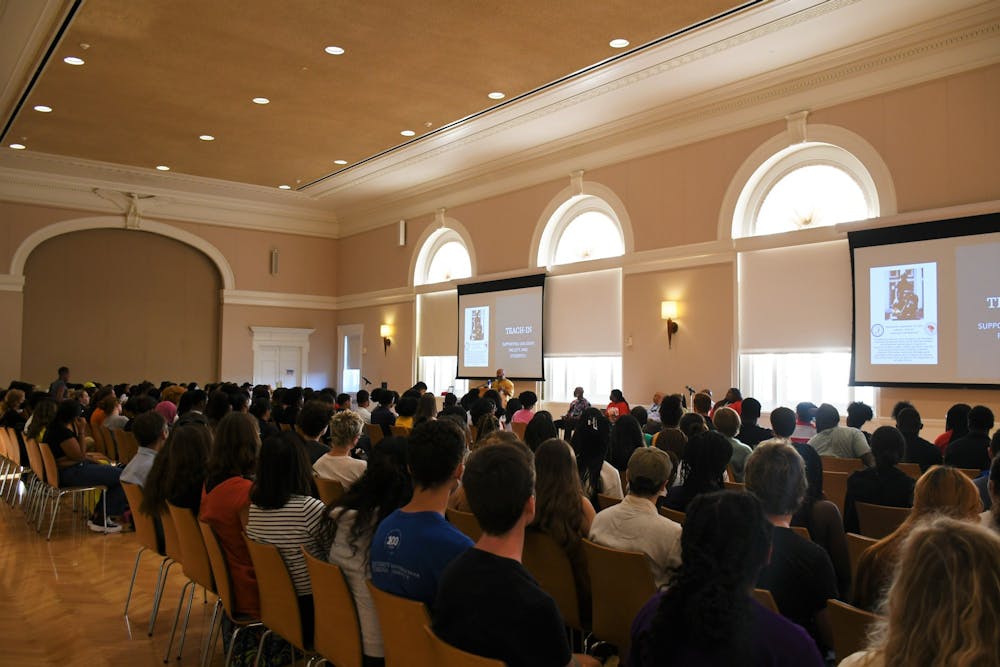The Carter G. Woodson Institute for African American Affairs and the Office of African American affairs hosted a teach-in aimed at contextualizing the recent vandalism of Dawson’s Row and the hate crime at the Homer statue and to offer a space for students to share reactions. Hosted in Newcomb Ballroom from 6:30 to 8 p.m. Wednesday, the gathering was open to the University community.
The teach-in follows the Aug. 19 vandalism of Dawson’s Row, in which an individual who has since been arrested broke two window panes of an OAAA building with a rock. A few weeks later, a hate crime was reported at the Homer statue after an individual hung a noose around the neck of the statue. Items were also left behind at the scene, though the University Police Department is still evaluating the items to determine their value with respect to the investigation.
In a recent update, the University Police Department confirmed that the suspect left behind additional items at the statue, and is evaluating whether the objects are relevant enough to the investigation to publicly release the information. Black students have since demanded increased transparency and information regarding the investigation.
According to a statement made Sept. 8 by Timothy Longo, vice president for security and safety and chief of police, and Interim OAAA Dean Michael Gerard Mason, the vandalism and hate crime were unrelated. Student groups have also responded to the events, with organizations like Young Democratic Socialists of America at U.Va. hosting a protest to demand a stronger University response to acts of white supremacy.
Wednesday’s teach-in began with brief comments from Mason, who said it was essential to assemble and acknowledge the events of the vandalism and hate crime in order to prevent similar occurrences.
“We hope to better understand where, when and how this moment and moments like it began and continue,” Mason said.
In an interview with The Cavalier Daily, Robert Vinson, director and chair of the Woodson Institute said that the noose’s historical context alludes to the act’s intentions.
“That's one of many indicators that [some communities are not] welcome in [this] particular space as full human beings,” Vinson said.
Following panelist remarks at the teach-in, leaders opened the floor for the audience to share thoughts on the events and ask questions.
Local attorney Stephanie Commander asked how University organizers can better coordinate efforts with the greater Charlottesville community.
Vinson replied that he hopes University students and faculty will continue expanding their efforts past Grounds in order to gain long-lasting support that remains steady even as groups of students graduate.
“In the larger space of the college campus, it's easy just to stay in this bubble and not get to know and engage the outside community,” Vinson said. “As a newcomer, this is an objective, getting out there and learning what's happening in the larger community, and then we build our power exponentially in that way.”
Zyahna Bryant, local activist and fourth-year College student, also participated in the teach-in and encouraged students to get involved with tutoring in Charlottesville public schools, and to push the University to utilize its $14.5 billion dollar endowment towards local educational resources.
The University's 2030 Plan — a set of goals for the next decade — lists relationships with the Charlottesville community, such as accessible and affordable educational programs, as an area for expansion.
“The University often extracts from the community in Charlottesville, specifically the Black community, and fails to pour back in,” Bryant said. “I don’t think we can ever get too big [in donations] when the University has a multibillion dollar endowment.”
Turning the attention to within the University, third-year College student Tasia Courts emphasized the role of organizations such as YDSA that aim to support Black students’ safety without increasing policing. She said that she at times felt helpless, but said there is power in Black students simply by attending the University.
“Part of our protest is being here,” Courts said. “At U.Va, the bricks that we walk by every day were laid by our ancestors. So being here is an act of resistance.”
Mason said that Black students should make the most of their experiences at the University in order to combat discrimination. “To learn is protest, and to learn well is even more so,” Mason said.







